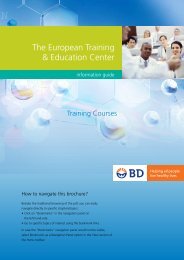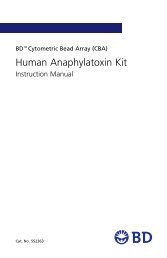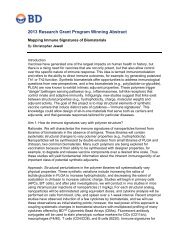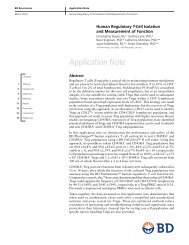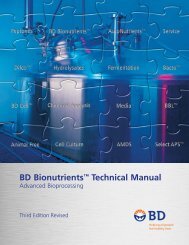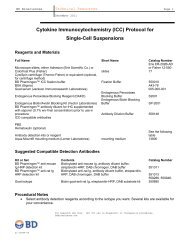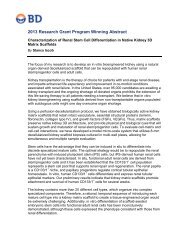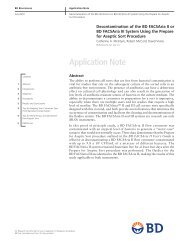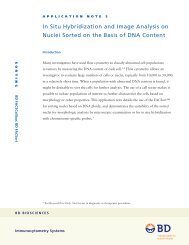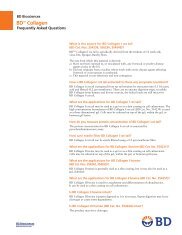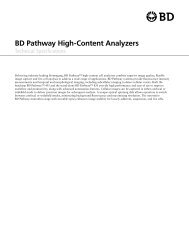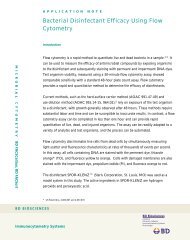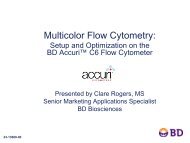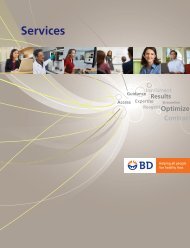New Approach to Effectively Modulate and Redirect the Autoimmune ...
New Approach to Effectively Modulate and Redirect the Autoimmune ...
New Approach to Effectively Modulate and Redirect the Autoimmune ...
You also want an ePaper? Increase the reach of your titles
YUMPU automatically turns print PDFs into web optimized ePapers that Google loves.
2012 Research Grant Program Winning Abstract<br />
<strong>New</strong> <strong>Approach</strong> <strong>to</strong> <strong>Effectively</strong> <strong>Modulate</strong> <strong>and</strong> <strong>Redirect</strong> <strong>the</strong> Au<strong>to</strong>immune<br />
Response in T1D Patients: Phenotypical <strong>and</strong> Functional Analysis of <strong>the</strong><br />
Components<br />
By Alessia Zoso<br />
Type 1 diabetes (T1D) is an au<strong>to</strong>immune disease in which <strong>the</strong> immune system<br />
recognizes <strong>and</strong> specifically eliminates insulin producing beta cells <strong>and</strong> consequently<br />
results in impaired blood glucose control, inducing poor blood circulation, heart disease,<br />
kidney failure, stroke, infection, <strong>and</strong> eventually death. Currently, <strong>the</strong> main approaches<br />
used <strong>to</strong> control disease progression consist of daily exogenous insulin administration<br />
<strong>and</strong> pancreas transplantation. Ei<strong>the</strong>r approach, though, does not attempt <strong>to</strong> solve <strong>the</strong><br />
immunological alterations that represent a crucial aspect in <strong>the</strong> development <strong>and</strong><br />
progression of <strong>the</strong> disease. Moreover, <strong>the</strong> complexity <strong>and</strong> polyclonal nature of <strong>the</strong><br />
au<strong>to</strong>immune response in T1D patients makes any attempt <strong>to</strong> revert/modulate it<br />
extremely challenging. Never<strong>the</strong>less important accomplishments have been achieved<br />
with a new strategy, now established in our department, which is aimed at controlling<br />
<strong>and</strong> redirecting <strong>the</strong> T1D au<strong>to</strong>immunity by using cord blood derived stem cells as in vitro<br />
“educa<strong>to</strong>rs.”<br />
Briefly, cord blood cells cultured on highly adherent surfaces for 2–3 weeks are used <strong>to</strong><br />
“educate” T1D patients’ peripheral blood mononuclear cells (PBMCs) by a 2-hour coincubation.<br />
The au<strong>to</strong>logous “educated PBMCs” are <strong>the</strong>n reinfused in <strong>the</strong> diabetic patient.<br />
Clinical data show that this approach significantly increases C-peptide production,<br />
reduces glycated-hemoglobin, <strong>and</strong> promotes generation of T regula<strong>to</strong>ry cells (Tregs)<br />
able <strong>to</strong> control T1D progression. Fur<strong>the</strong>rmore, <strong>the</strong> approach was extremely safe, with no<br />
graft-versus-host reaction or significant adverse events. Preclinical data in <strong>the</strong> nonobese<br />
diabetic model indicate that this approach not only promotes <strong>the</strong> in vivo generation of<br />
CD4 + /CD62L + Tregs, but also allows pancreatic beta cell regeneration. Thus, both<br />
clinical <strong>and</strong> preclinical results indicate <strong>the</strong> capacity of cultured cord blood derived cells <strong>to</strong><br />
<strong>to</strong>lerize <strong>the</strong> patients’ PBMCs <strong>and</strong> <strong>to</strong> partially revert T1D. Never<strong>the</strong>less, it is still unknown<br />
which umbilical cord blood population/s is responsible for this <strong>the</strong>rapeutic effect <strong>and</strong><br />
what fine mechanisms are involved. Their comprehension is necessary for maximizing<br />
<strong>the</strong> <strong>the</strong>rapeutic efficacy <strong>and</strong> heading <strong>to</strong>ward a cure for T1D. Toward this goal we<br />
propose <strong>the</strong> following aims:<br />
AIM 1: Analysis of <strong>the</strong> stem cells educa<strong>to</strong>r. Using several panels of specific anti-human<br />
antibodies from BD Biosciences, we will perform an extensive flow cy<strong>to</strong>metry analysis on<br />
<strong>the</strong> cord blood units used <strong>to</strong> prepare <strong>the</strong> stem cells educa<strong>to</strong>r. In particular we will<br />
evaluate <strong>the</strong> content <strong>and</strong> quality of different immune components (monocytes,<br />
granulocytes, DCs, T cells, Tregs, B cells) at different time points: 1) before plating <strong>the</strong><br />
cells, 2) before adding <strong>the</strong> patient’s PBMCs <strong>to</strong> <strong>the</strong> educa<strong>to</strong>r cells, <strong>and</strong> 3) after <strong>the</strong> coculture<br />
with <strong>the</strong> patient’s cells. This analysis will help us in defining possible critical <strong>and</strong><br />
functional changes that <strong>the</strong> initial cord blood units will undergo during <strong>the</strong> educa<strong>to</strong>r<br />
preparation <strong>and</strong> co-culture with <strong>the</strong> patient’s PBMCs. Fur<strong>the</strong>rmore, we will functionally<br />
analyze <strong>the</strong> educa<strong>to</strong>r cells with particular attention <strong>to</strong>: 1) <strong>the</strong>ir immune-suppressive
activity <strong>to</strong>ward <strong>the</strong> proliferation of CFSE activated T cells obtained from T1D patients or<br />
healthy donors; <strong>and</strong> 2) <strong>the</strong>ir capacity <strong>to</strong> induce Treg expansion. Both CD4 + <strong>and</strong> CD8 + T-<br />
cell proliferation will be evaluated as CFSE dilution by flow cy<strong>to</strong>metry.<br />
AIM 2: Analysis of T1D patient’s educated cells. T1D <strong>and</strong> healthy donor PBMCs will be<br />
evaluated phenotypically by flow cy<strong>to</strong>metry using panels of antibodies for lymphoid (ie, T<br />
<strong>and</strong> B cells, Tregs, etc), myeloid (macrophage, myeloid derived suppressor cells,<br />
immature cells, etc), <strong>and</strong> DC (conventional <strong>and</strong> plasmacy<strong>to</strong>id) subsets. Functionally,<br />
PBMCs will be tested by proliferation assay, <strong>and</strong> both phenotype <strong>and</strong> functionality will be<br />
evaluated on fresh isolated PBMCs before <strong>and</strong> after <strong>the</strong> co-culture with <strong>the</strong> educa<strong>to</strong>r<br />
cells. This set of experiments should reveal crucial changes in <strong>the</strong> patient’s PBMCs that<br />
occur during <strong>the</strong> incubation with <strong>the</strong> educa<strong>to</strong>r cells.<br />
AIM 3: Role of soluble fac<strong>to</strong>rs in mediating <strong>the</strong> stem cells educa<strong>to</strong>r function. Our recent<br />
data prove <strong>the</strong> importance of <strong>the</strong> soluble fac<strong>to</strong>r, released upon interaction between<br />
activated T cells <strong>and</strong> cord blood derived suppressive cells, for <strong>the</strong> generation/expansion<br />
of FoxP3 + CD4 + Tregs. We will compare this finding <strong>to</strong> <strong>the</strong> stem cells educa<strong>to</strong>r approach<br />
by evaluating <strong>the</strong> cy<strong>to</strong>kine profile of <strong>the</strong> culture media used in <strong>the</strong> apparatus at different<br />
time points: 1) Time 0: media before starting <strong>the</strong> educa<strong>to</strong>r preparation; 2) Time 1: culture<br />
media of <strong>the</strong> stem cells educa<strong>to</strong>r before adding <strong>the</strong> PBMCs, <strong>and</strong> 3) Time 2: culture<br />
media at <strong>the</strong> time of PBMC collection <strong>and</strong> reinfusion in <strong>the</strong> patient. A cy<strong>to</strong>kine profile also<br />
would be run on <strong>the</strong> serum sample obtained from <strong>the</strong> patients before <strong>and</strong> 4 weeks after<br />
cell reinfusion. Control media will be collected from <strong>the</strong> following cells cultures: a) cord<br />
blood alone; b) PBMCs alone; c) PBMCs cultured with an irrelevant cell line (HEK-293).<br />
All <strong>the</strong> samples will be analyzed at once for <strong>the</strong> expression of several cy<strong>to</strong>kines using<br />
<strong>the</strong> BD Cy<strong>to</strong>metric Bead Array, a multiplex bead-based immunoassay.<br />
This study will be of extreme importance, not only <strong>to</strong> better underst<strong>and</strong> <strong>the</strong> stem cells<br />
educa<strong>to</strong>r functionality, but also <strong>to</strong> identify new mechanisms <strong>and</strong> fac<strong>to</strong>rs with critical roles<br />
in <strong>the</strong> treatment of T1D.<br />
The BD Biosciences Research Grant Program aims <strong>to</strong> reward <strong>and</strong> enable important<br />
research by providing vital funding for scientists pursuing innovative experiments <strong>to</strong><br />
advance <strong>the</strong> scientific underst<strong>and</strong>ing of disease.<br />
Visit bdbiosciences.com/grant <strong>to</strong> learn more <strong>and</strong> apply online.



